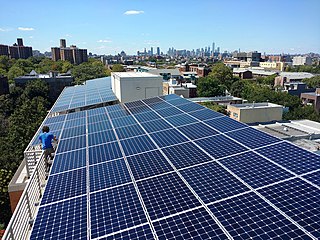
Solar power is a major contributor to electricity supply in Australia. As of December 2023, Australia's over 3.69 million solar PV installations had a combined capacity of 34.2 GW photovoltaic (PV) solar power. In 2019, 59 solar PV projects with a combined capacity of 2,881 MW were either under construction, constructed or due to start construction having reached financial closure. Solar accounted for 12.4% of Australia's total electrical energy production in 2021.

Solar power includes solar farms as well as local distributed generation, mostly on rooftops and increasingly from community solar arrays. In 2023, utility-scale solar power generated 164.5 terawatt-hours (TWh), or 3.9% of electricity in the United States. Total solar generation that year, including estimated small-scale photovoltaic generation, was 238 TWh.

Historically, the main applications of solar energy technologies in Canada have been non-electric active solar system applications for space heating, water heating and drying crops and lumber. In 2001, there were more than 12,000 residential solar water heating systems and 300 commercial/ industrial solar hot water systems in use. These systems presently comprise a small fraction of Canada's energy use, but some government studies suggest they could make up as much as five percent of the country's energy needs by the year 2025.

As of April 2020, the energy sector in Senegal has an installed capacity of 1431 megawatts (MW). Energy is produced by private operators and sold to the Senelec energy corporation. According to a 2020 report by the International Energy Agency, Senegal had nearly 70% of the country connected to the national grid. Current government strategies for electrification include investments in off-grid solar and connection to the grid.

The energy sector in Hawaii has rapidly adopted solar power due to the high costs of electricity, and good solar resources, and has one of the highest per capita rates of solar power in the United States. Hawaii's imported energy costs, mostly for imported petroleum and coal, are three to four times higher than the mainland, so Hawaii has motivation to become one of the highest users of solar energy. Hawaii was the first state in the United States to reach grid parity for photovoltaics. Its tropical location provides abundant ambient energy.

A photovoltaic power station, also known as a solar park, solar farm, or solar power plant, is a large-scale grid-connected photovoltaic power system designed for the supply of merchant power. They are different from most building-mounted and other decentralized solar power because they supply power at the utility level, rather than to a local user or users. Utility-scale solar is sometimes used to describe this type of project.

Solar power in South Africa includes photovoltaics (PV) as well as concentrated solar power (CSP). As of July 2024, South Africa had 2,287 MW of installed utility-scale PV solar power capacity in its grid, in addition to 5,791 MW of rooftop solar and 500 MW of CSP. Installed capacity is expected to reach 8,400 MW by 2030.
Solar power in Chile is an increasingly important source of energy. Total installed photovoltaic (PV) capacity in Chile reached 8.36 GW in 2023. Solar energy provided 19.9% of national electricity generation in Chile in 2023, compared to less than 0.1% in 2013.

Copperbelt Energy Corporation Plc (CEC) is a Zambian electricity generation, transmission, distribution and supply company with operations in Zambia and Nigeria. The company is listed on the Lusaka Stock Exchange
Mayuge Solar Power Station, also Bufulubi Solar Power Station, is an operational 10 MW (13,000 hp) solar power plant in Uganda.
Zambia is potentially self-sufficient in sources of electricity, coal, biomass and renewable energy. The only energy source where the country is not self-sufficient is petroleum energy. Many of the sources of energy where the country is self-sufficient are largely unexploited. As of 2017, the country's electricity generating capacity stood at 1,901 megawatts.
Kanzimbe Solar Power Station, is a 60 megawatts (80,000 hp) solar power plant, in Malawi, in Southern Africa. The power station was constructed between December 2018 and November 2021.
Kafue Gorge Lower Power Station (KGL), is a 750 megawatts (1,010,000 hp) hydroelectric power station in Zambia.
The Serenje Solar Power Station is a proposed 200 MW (270,000 hp) solar power plant in Zambia. The project is rated as the largest solar project in the country. The power station is under development by Ultra Green Corporation Zambia Limited, a subsidiary of Ultra Green Corporation Inc., an American independent power producer (IPP).
Ngonye Solar Power Station (NSPS), is a 34 MW (46,000 hp) solar power plant in Zambia. The solar farm that was commercially commissioned in April 2019, was developed and is owned by a consortium comprising Enel Green Power of Italy, a multinational renewable energy corporation, and the Industrial Development Corporation of Zambia (IDC), a parastatal company. The power station cost about US$40 million to develop.
The Kalulushi Concentrated Solar Power Station, also Kalulushi CSP Station, is a proposed 200 MW (270,000 hp) concentrated solar power plant in Zambia. The power station is under development by three IPPs, Margam Valley Solar Energy Corporation, Afrisolar Power and EnergyLine Zambia. The power generated here will be integrated into the national grid through Zambia Electricity Supply Corporation Limited (ZESCO).
The Caraculo Solar Power Station is a planned 50 MW (67,000 hp) solar power plant in Angola. The power station is owned and operated by a consortium comprising Eni, the Italian energy multinational, in collaboration with Sonangol, the Angolan energy parastatal. On 31 May 2023, 25 MW of power came online, in the first phase with another 25 megawatts to follow.
The Zambia Riverside Solar Power Station is a 34 megawatts solar power plant in Zambia. The privately owned solar farm was originally commissioned in April 2018, as a 1 MW power station by Copperbelt Energy Corporation (CEC), who own the energy infrastructure. In December 2021, CEC signed an engineering, procurement, and construction (EPC) contract with Sinohydro to expand the solar farm by 33 extra MW over the next 12 months. CEC transmits and distributes the power to its customers in the Copperbelt Province of Zambia.
The Choma Solar Power Station is a solar power plant, under development in Zambia, with generation capacity of 60 megawatts and an attached 20 MWh battery energy storage system (BESS). The privately owned solar farm is being developed by a joint venture company, comprising "YEO Teknoloji Enerji ve Endustri AS" (YEO), a Turkish energy company and "GEI Power Limited", a Zambian independent power producer (IPP). The off-taker is ZESCO, the national electricity utility, under a long-term power purchase agreement (PPA).








